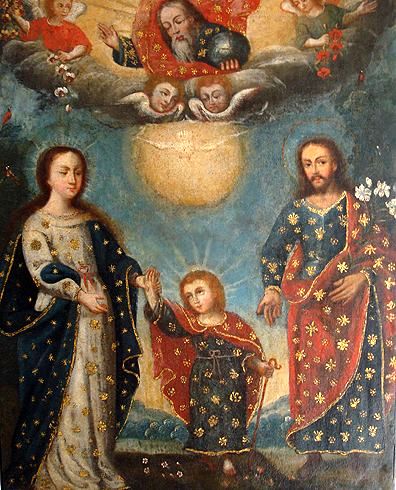High Roads to Colonial Art - "Escuela Cuzqueña" Influence in the Philippines
 |
| One of the wood panel paintings -"San Cristobal" in Paete Church, Laguna. By Jose Luciano Dans (1805 - 1870) Wiki |
One curious cargo of the "Nao de China" or the trading galleons of the Manila-Acapulco trade route in the early 17th century were objects for the propagation of the Christian faith - religious artworks. These artworks held great importance for religious orders, and any duties associated with their transport were waived due to their significance.
This Catholic religious artistic tradition came to be known as the "Escuela Cuzqueña" (The Cuzco School).
In the early years of evangelization in the Americas, the art of painting religious themes also flourished in the high Andes. Baroque art, with some of its known movements like Mannerism, influenced the Cusco art tradition. European artists also came to work there on some of the church's large undertakings.
The demand for icons and religious art increased, leading to the spread of the "Escuela Cuzqueña" throughout Spanish possessions in the New World. Here's a curious fact: The unique beasts of burden of the Andes, like llamas and alpacas, played a significant role in this. These animals carried objects and artworks from the region along the high roads descending to trading posts in the Peruvian highlands, eventually reaching Mexico, where many local artisans copied and disseminated the style.
This religious art tradition had to cross the vast Pacific Ocean.
In Paete, Laguna, the church of Saint James the Apostle has a mural of St. Christopher that is very indicative of the styles and influence of Spanish colonial art. Local lore tells the story of how the first "San Cristobal" painted by local artist Jose Luciano Dans was disliked by the priest for being too oriental, depicting the saint with a sword, resembling a character from a local Moro-Moro play. A second painting had to be commissioned. The styles and colors are reminiscent of the unique kind of Baroque Mannerism that developed in Cuzco and spread throughout the Americas.
I recall one of my grandmother's prized possessions, which she kept in her cartamoneda (wallet). It was a "stampita" of Santa Rosa de Lima. The artwork's somewhat crude presentation comes to mind now, and I can't help but imagine the long journey it took to reach here.
 |
"San Cristobal" by Quechuan artist Basilio de Santa Cruz Pumacallao (1661-1700) Cusco Peru, ARCA Arte Colonial |



.png)


Comments
Post a Comment